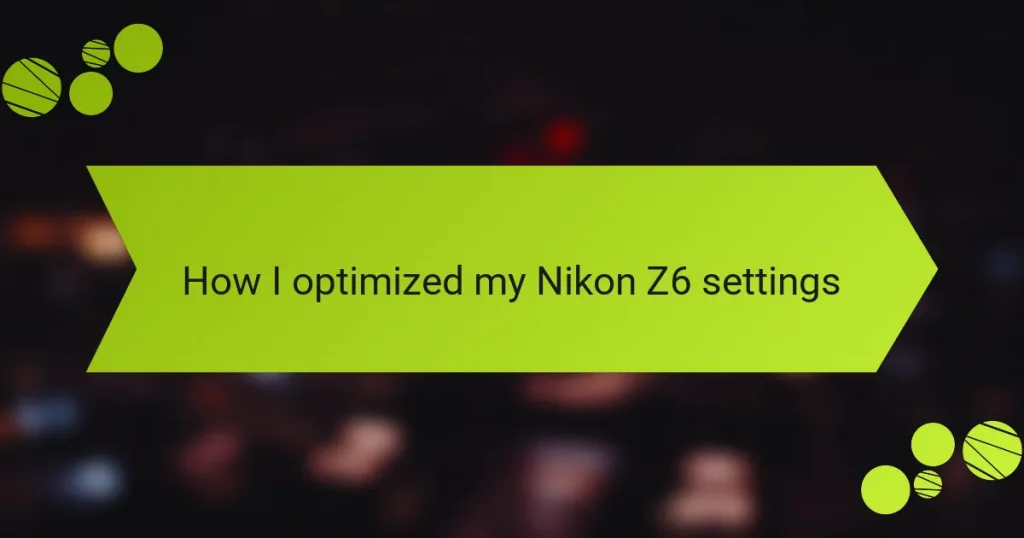Key takeaways
- The Nikon Z6 features a 24.5-megapixel sensor, exceptional autofocus system with 273 focus points, and effective in-body image stabilization, making it ideal for low-light photography and capturing fast-moving subjects.
- Understanding and optimizing camera settings like ISO, aperture, shutter speed, and white balance are crucial for enhancing image quality and adapting to different shooting environments.
- Beginners should focus on basic settings such as image quality (set to RAW), single-point autofocus mode, and matrix metering for balanced exposures to improve their photography skills.
- Advanced users can benefit from customizing autofocus modes, exposure compensation, and utilizing dual card slots for flexible storage and post-processing options.

Overview of Nikon Z6 features
The Nikon Z6 is a remarkable camera that strikes a perfect balance between power and versatility. With its full-frame 24.5-megapixel sensor, I’ve found that it delivers stunning image quality, especially in low-light conditions. It’s amazing how much detail you can capture even when you’re out during the golden hour, isn’t it?
One feature that genuinely excites me is its exceptional autofocus system. Out of the box, it boasts 273 focus points, ensuring that I never miss the action, whether I’m shooting portraits or fast-moving subjects like wildlife. Have you ever struggled with focusing in challenging situations? I certainly have, but with the Z6, I’ve gained more confidence in my shots.
The in-body image stabilization (IBIS) is another game changer, compensating for camera shake up to five stops. I remember a time when I struggled with blurry images—now, I can comfortably shoot at slower shutter speeds. Isn’t it nice to think that you could get sharp shots even when the lighting isn’t perfect?
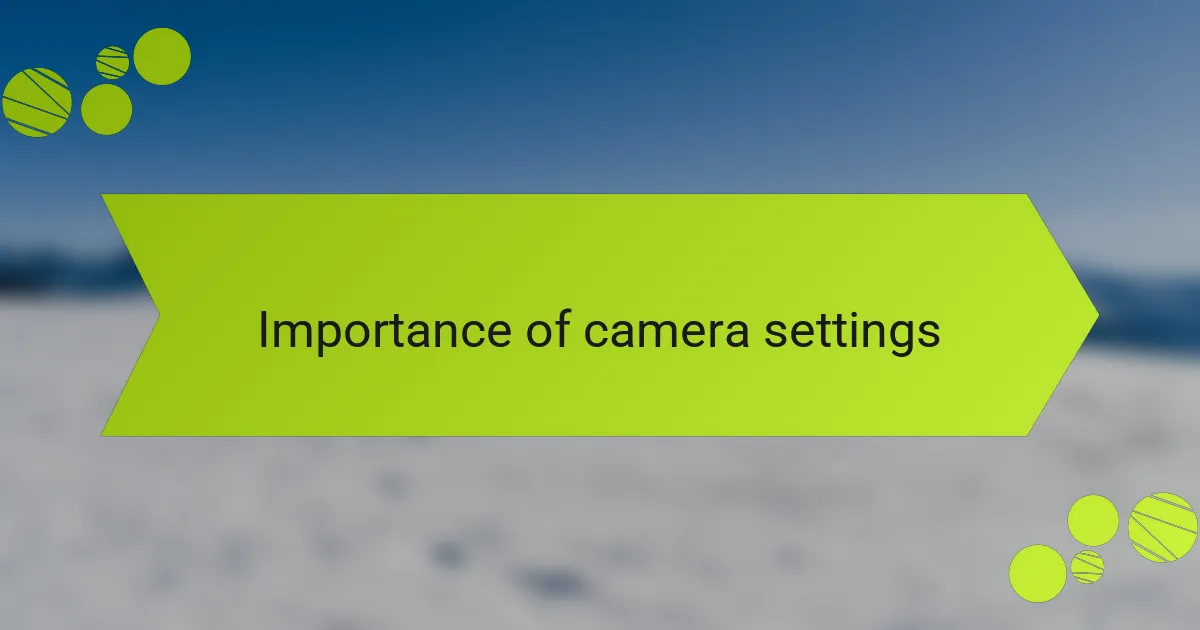
Importance of camera settings
When I first started using my Nikon Z6, I quickly realized that the camera settings could make or break a shot. I often found myself frustrated when my images didn’t match my vision, which compelled me to dive deep into understanding each setting. It became clear that optimizing these settings was essential for capturing the stunning photos I wanted and truly expressing my creativity.
Through trial and error, I learned that taking the time to adjust settings allowed me to enhance image quality and adapt to various shooting environments. Accurate exposure and focusing contributed significantly to the overall mood of my photographs. Here are some key camera settings that I focused on to elevate my photography:
- ISO: Adjusting ISO depending on lighting conditions to reduce noise.
- Aperture: Setting a wider aperture for beautiful background blur when I wanted to isolate subjects.
- Shutter Speed: Choosing faster shutter speeds for action shots helped freeze motion.
- White Balance: Customizing white balance to match the ambient light improved color accuracy.
- Picture Profiles: Exploring different profiles like Flat or Vivid to experiment with post-processing flexibility.
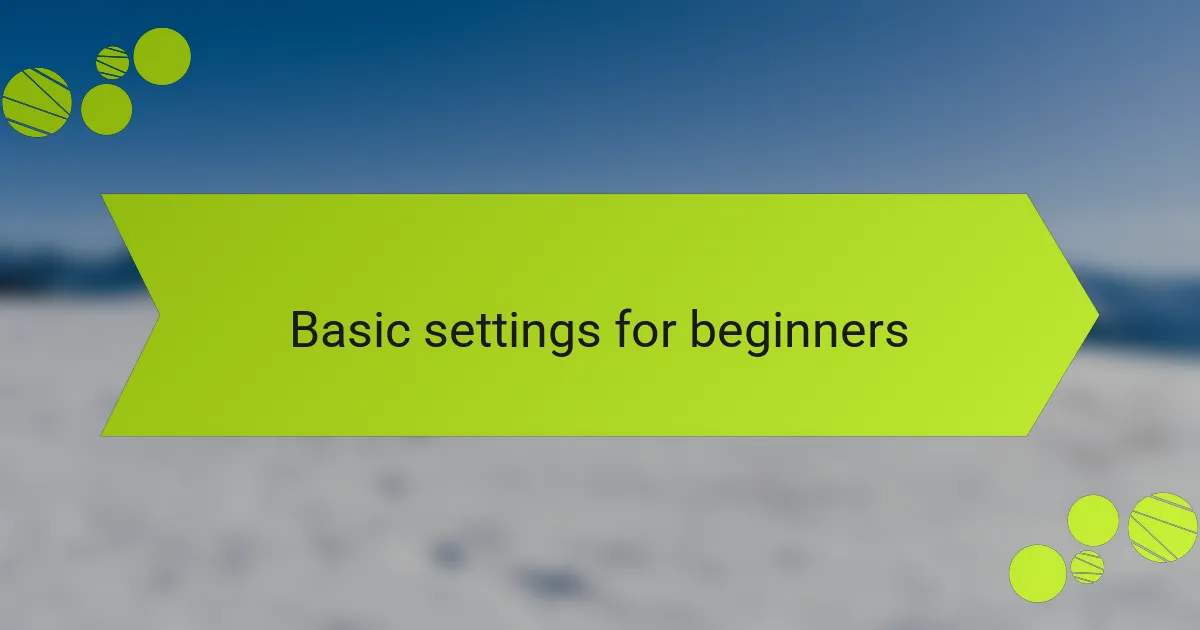
Basic settings for beginners
Starting with the Nikon Z6, I found it essential to get comfortable with the basic settings. This camera offers a user-friendly interface, making it perfect for beginners. When I picked it up for the first time, I felt a mix of excitement and nervousness about how to set it up. After some experimentation, I realized that focusing on a few key settings helped me get the most out of my shoots.
Here are some basic settings you might want to adjust as a beginner:
- Image Quality: Set to RAW for maximum editing flexibility later.
- Auto Focus Mode: Use Single-Point AF for precise control in still photography.
- Metering Mode: Start with Matrix metering for balanced exposures in most situations.
- ISO Sensitivity: Keep it on Auto for low-light scenarios, adjusting manually as you gain confidence.
- White Balance: Set to Auto; you can fine-tune it later depending on your shooting conditions.
By tweaking these fundamental settings, you can pave the way for better photos and more enjoyable shooting experiences. Each small adjustment contributed to my learning curve and boosted my confidence behind the lens.
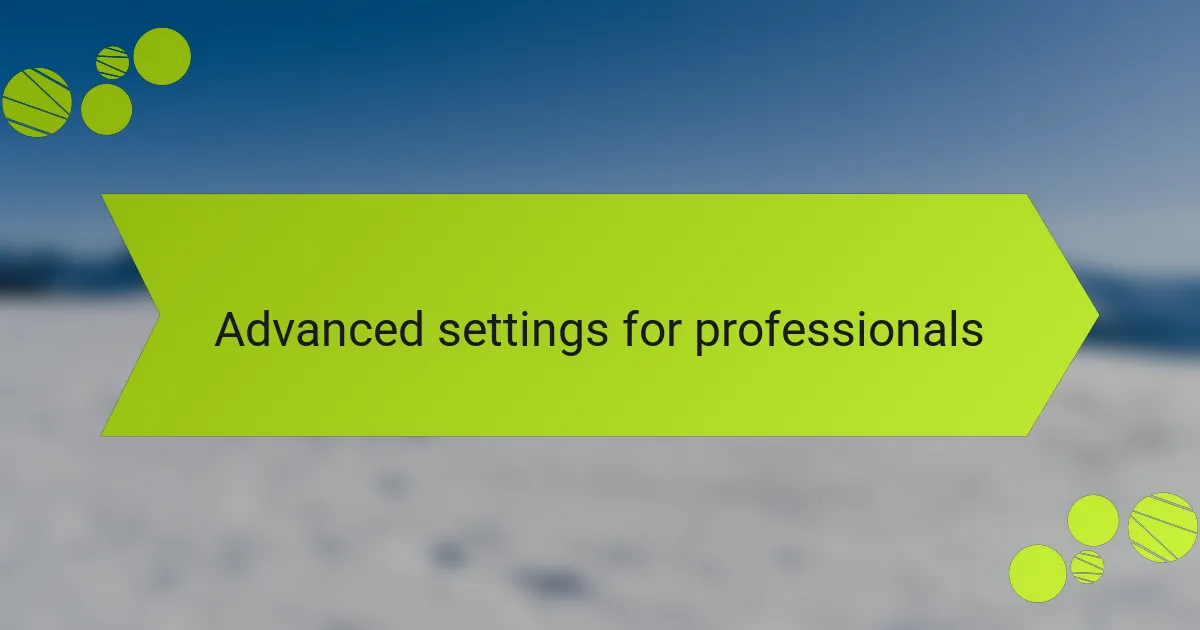
Advanced settings for professionals
When I first dove into the advanced settings of my Nikon Z6, I was amazed by how much the camera could really cater to my shooting style. The ability to customize things like autofocus settings and exposure metering made a considerable difference, especially during challenging lighting conditions. I recall a particular evening shoot where the sun was quickly setting, and tweaking my ISO and shutter speed settings allowed me to capture that ephemeral golden glow just perfectly.
Here are some advanced settings I recommend trying out:
- Autofocus Modes: Experiment with AF-S (Single) for still subjects and AF-C (Continuous) for moving subjects to ensure sharp focus.
- Custom Control Assignment: Tailor the function buttons to quickly access critical settings like ISO and white balance.
- Picture Control: Fine-tune sharpness, contrast, and saturation to suit your scene, giving your images a personal touch.
- Exposure Compensation: Don’t hesitate to adjust this on the fly—it can save a shot in tricky light conditions.
- Dual Card Slots: Use one card for RAW files and the other for JPEG, allowing for flexibility in post-processing and quicker sharing.
These settings not only enhanced my photography experience but also instilled a sense of confidence in my shooting capabilities.
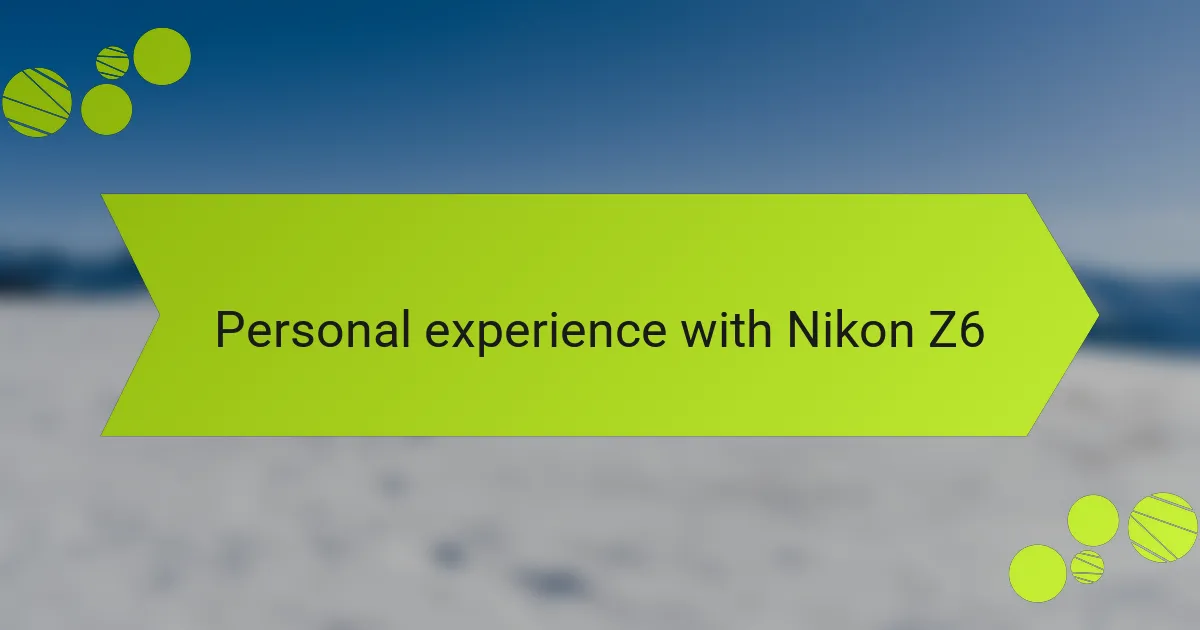
Personal experience with Nikon Z6
My journey with the Nikon Z6 has been nothing short of transformative. The moment I picked it up, I felt a connection — its weight, balance, and those intuitive controls just clicked with my shooting style. I remember capturing the first sunset with it; the colors were vibrant and rich, bringing my vision to life in ways I hadn’t experienced before with my previous gear.
I often play with the focus settings based on the scene, and I’m always amazed by how quickly the eye-detection autofocus locks onto my subjects. This reliability has made a huge difference, especially when photographing moving subjects, like my kids playing in the park. It’s moments like these that have deepened my appreciation for the camera and its capabilities.
| Setting | My Preference |
|---|---|
| ISO | Auto up to 6400 |
| Aperture | f/4 for landscapes, f/1.8 for portraits |
| Shutter Speed | 1/250 for moving subjects |
| White Balance | Auto |
| Focus Mode | Continuous AF |
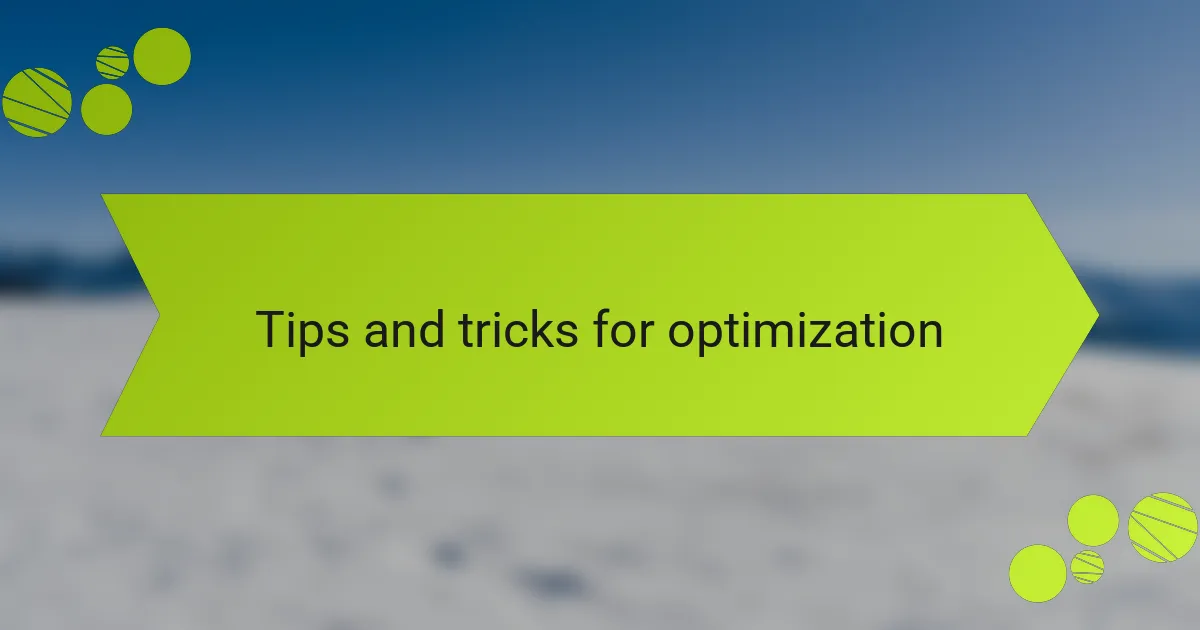
Tips and tricks for optimization
When I first started using my Nikon Z6, I felt a bit overwhelmed by the myriad settings and options. It took some trial and error, but I discovered that customizing the focus modes significantly improved my photos—especially in dynamic situations. Switching to the “Wide Area AF” mode was a game changer for capturing my active kids during family outings.
My journey to optimizing the Z6 also involved dialing in the right picture control settings. I experimented with different styles, and I found that using the “Vivid” setting helped my landscape photos pop with color. It was like watching the world unfold in richer tones right before my eyes. Here are some tips and tricks I found helpful for optimization:
- Adjust the autofocus settings for your shooting environment.
- Utilize the “My Menu” feature to access frequently used settings quickly.
- Experiment with custom shooting modes (like “A” for aperture priority) for different situations.
- Keep the camera firmware updated to ensure access to the latest features.
- Play around with custom buttons for easy access to settings, reducing time spent navigating menus.
